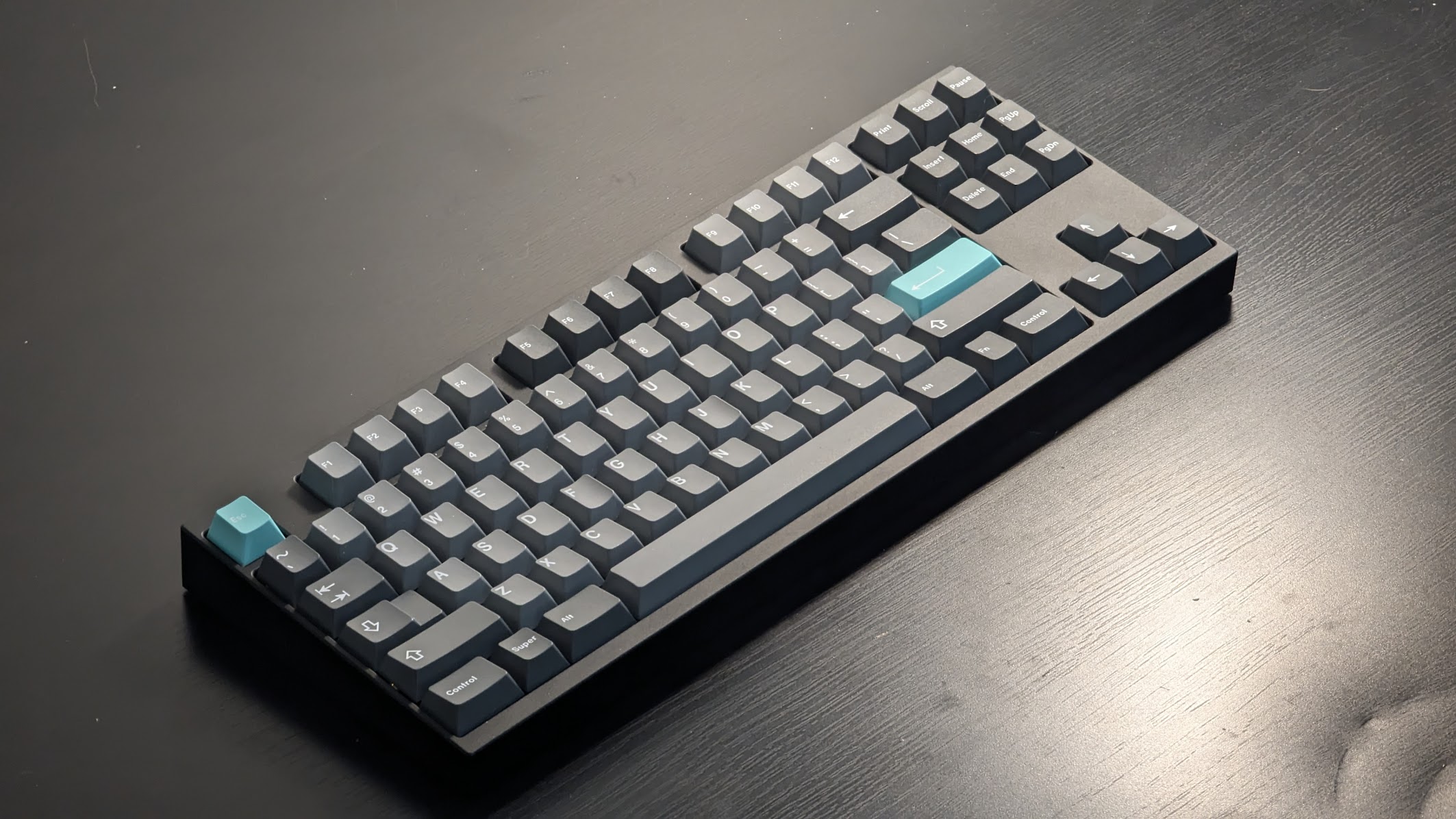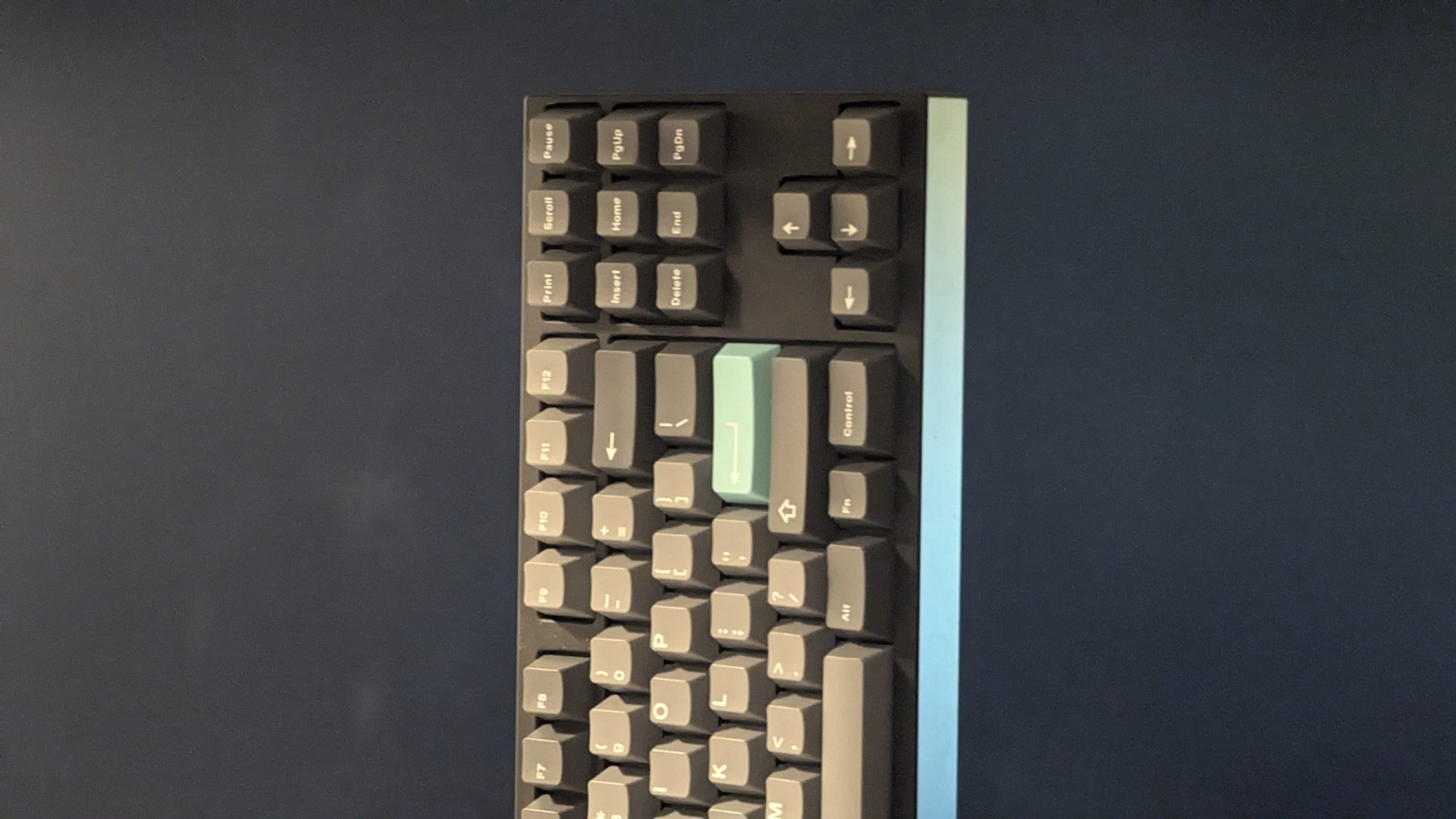Milan
Some time in 2024, what I truly needed was apparent to me. The tried-and-true top-mount TKL with a plastic plate with Cherry switches with a coveted GMK set. Well, what actually happened is that I got GMK Modern Dolch 2 as an unvaulted product from Omnitype’s Happiest Hour sale in May of 2024 (also managed to snag a Mist set for my stepfather!). Modern Dolch was a chase set for pretty much as long as I got into keyboards after seeing Hamaji Neo’s “The Making of My $850 Custom Mechanical Keyboard“ in which he built a Mode 80 with a custom cerakote matching the color of Modern Dolch as well as Durock T1s (never again), and it was pure bliss to see it all come together, even if the sound is really not something that holds up in 2025. Regardless, when I got my set of Modern Dolch, I knew right away it was a sign to grab myself a nice TKL deserving of it. That’s when I was recommended the Milan for a combination of it being good quality (MakerKeyboards does a great job of making boards) and surprisingly cheap.
Design/Aesthetics
The design of the Milan is very much a get-what-you-pay-for construction. It’s hardly different to that of a Tofu being a completely sterile wedge design with not even a design on the bottom to speak of. And sometimes, that’s okay: Sometimes a board simply needs to remain understated in its design and instead put its money where its mouth is in the sound and feel department. The bottom of the Milan only presents the seam where the top case shrouds the bottom case, and an impressive only 4 long M2 hex screws holding the assembly together. The most flair this board presents is a pretty wide and decently thick brass weight on the inside of the board to help with taming the sound, as this thing without any weight would ping harder than the Liberty Bell.
With its supremely simple design, it also offers a great, low front height of 18mm, albeit at a rather low 3.7° angle, but it still ends up being very comfortable just on the basis of the front height alone.
Assembly
As previously mentioned, the construction of the Milan is very simple: 2 12mm M2 screws in the front and 2 20mm M2 screws in the back hold the cases together, and once removed the top shroud simply slides off. Very simple.
The Milan offers to mount a board in two methods: Gasket, which is only available with the aluminum plate, or top mount which is available for all plates. To get it out of the way, the gasket mount is incredibly okay. With the aluminum plate, it had decent pop, a good fullness, but it was still the average gasket mount experience that was offered by many boards at the time. Not to mention, the poron gaskets were non-adhesive, so they were an absolute pain to even get to stay in the board when assembling it, so not only was it already not in the plans to do a gasket mount, it was definitely something I avoided.
Instead, Top mount was the method to the madness here, and the make of the board was made with compatibility with KBDfan’s KBD8x MkII in mind, making it so that if you had parts from that board or the plate files (which are very much available), you could easily get replacement parts procured. With that in mind, I ended up going to Tom at HypeKeyboards (tom the goat) to get a couple of plates in polypropylene and polycarbonate made, as aluminum is generally recommended against for use in top mount due to the fact it creates a lot of thuddyness and resonance (case and plate, like materials bad, different materials good), while most non-metallic plates are recommended. With these plates as well, I also requested that Tom remove the mount points nearest to the spacebar, as mounting a spacebar and not letting it float freely can cause the spacebar’s sound to go flat and thuddy, while leaving it without a mount allows the sound to travel freely through the air rather than resonating through the case, and provides a less stiff feel.
PCB and Firmware
The Milan offers just two PCBs, a 6.25u layout and a 7u bottom row layout, with the only layout options per PCB being normal or stepped caps lock. While I do agree that F12 TKL looks its best with full modifiers, it is mildly disappointing to not at least see a split right shift or split backspace, or even an ISO option. Hell, not even a solder PCB is available for this board to give you all the regular options, as I assume they wanted to put the long-term support on KBDfan’s lap by treating this as a derivative product to the KBD8x MkII. It’s not the greatest decision, but it works and is all I can really ask. Both PCBs also include two very long flex cuts between R4 and R5 and R1 and R2, however it doesn’t seem to detract too much from the sound profile fortunately. I did try putting a thin layer of tape around those flex cuts and while it did slightly increase the volume, it did also consequentially modify the sound slightly closer to that tape mod sound that I’m not the biggest fan of. In the end, I did keep it taped, but with only one layer.
As per usual, the PCB is Via-ready QMK compatible as it is basically a toned-down KBD8x MkII PCB; it even shows as one when loading it in Via. The PCB is also has a PCB-mounted USB-C port which fortunately never caused a problem despite the USB cutout being nearly flush with the port, and honestly I am kinda glad they didn’t compromise the design with a daughterboard, as it keeps everything simple. It’s also worth mentioning that because of this mounted USB port, the two closest keys, F12 and Print Screen, are flipped to be north-facing to avoid interference with the port. It’s fairly inconsequential since it’s on R0, but when the 84 other switches are south-facing, it can catch you off guard.
Typing Experience
As previously mentioned, the aluminum plate gasket mount is very run of the mill as far as Cherries on alu gasket mount goes. Aluminum top mount similarly is very run of the mill, but is a detriment due to the like materials meeting together. FR4 offered a slightly deeper sound while still being mostly flat and stiff. Moving to the plastic plates make a world of difference for the top mount both in terms of sound and feel. The difference between polycarbonate and polypropylene is very minor, I would say nearly identical, however I found the polypropylene to be overall slightly more sharp, especially around the mods. The feel between both is just about identical as by the point of moving onto the plastics, they’re less rigid than the PCB made of FR4. For a while I stuck with regular Cherry Hyperglide Blacks, but when I got some Cherry Hyperglide Browns for the memes, they kind of just went in the board and stayed there and I think I like it because of the slightly snappier travel giving a small hint of extra volume.
| Milan |
|---|
 |
| Case Material • CNC Aluminum • CNC Brass (Internal Weight) |
| Plate • Aluminum • FR4 • Polypropylene (courtesy of HypeKeyboards) • Polycarbonate (courtesy of HypeKeyboards) |
| Mount • Top Mount • Gasket Mount |
| Included Parts • Rigid felt-interior Carry Case and Microfiber Cloth • Allen Key |
| Cost • $155 (sale, original $275!) |
| Release Date • 2022 |


Overview
For how cheap it is (A-stocks as of this review are sold out, with B-stock remaining at a lower price tag of $139), the Milan really pulls its weight in simply being a function over form kind of board. It’s very simple in its design which as mentioned, is not inherently bad on its own. A sleeper board is always welcome as long as it pulls its weight in some other way, which for me is usually in sound. At this price point, it ironically goes toe-to-toe against the newer KBD8x MkIII which unfortunately doesn’t continue the trend of compatible PCBs, but is still a very heavy-hitting TKL with a great price proposition. In today’s market, I’d probably choose that over the Milan, but I am still really happy with my Milan and think it serves its purpose very well.
Gallery
This article is not sponsored or compensated for in any way. This article falls under Fair Use and adheres to the Copyrights of the mentioned brands. Any mistakes, feedback or clarifications may be directed to askme@cheesemanfuu.com.